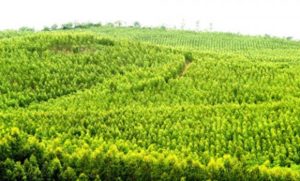AGRO FORESTRY
Few industries in India can match the sustainability that paper offers. It is fully biodegradable and can be recycled up to 6-7 times. Moreover, it is made from resources that are renewable and can be easily regenerated. The Paper industry is not only conserving the environment but also regenerating natural resources.
In India, paper is produced from three alternate raw material – (1) wood/bamboo; (2) agro residue (bagasse/wheat straw), (3) waste paper / recycled fibre (RCF). Around 21% of the total paper produced in India uses wood as the primary raw material.
India is a fibre deficient country. Inadequate raw material availability domestically is a major constraint for the Paper Industry. Availability of wood domestically at 9 million tonnes per annum (TPA) is inadequate compared to demand, which is currently about 11 million TPA and is projected to rise to 15 million TPA by 2024-25. Consequently, the cost of wood has been going up significantly over the years.
Unlike in some parts of the world, the Paper Industry in India is not a forest-based industry but is an agro / farm forestry-based industry. India’s Paper Industry has agroforestry roots and strong backward linkages with the farming community, from whom wood, which is a key raw material, is sourced. Of the total demand for wood, over 90% is sourced from industry-driven agro / farm forestry, with the rest from the government and other sources. India’s Paper Industry is wood-positive, that is, it plants more trees than it harvests.
Pioneering work has been carried out by the Paper Industry over the last three decades in producing high-quality tree clonal saplings (e.g. Eucalyptus, Subabul, Casuarina, Acacia, Poplar, etc.) which are disease and drought-resistant and can be grown in a variety of agro-climatic conditions. A large part of this wood is grown in backward marginal / sub-marginal land, which is potentially unfit for other use. Farmers grow trees, which are called trees-outside-forests (TOFs), as any other crop and their harvest is sold to paper mills, apart from other industries.
Substantial amounts have been spent by the Paper Industry on plantation R&D, production of high-quality tree clonal saplings, technical extension services to improve agro / farm forestry services, handholding of marginal farmers over a gestation period of 4-5 years.
In India, an estimated 500,000 farmers are engaged in growing plantations of Eucalyptus, Subabul, Casuarina, Acacia, Poplar, etc. On average, about 125,000 hectares are being brought under agro / farm forestry on an annual basis, with around 1.2 million hectares on a cumulative basis across the country, due to intensive efforts mounted by paper mills over the last several years. This has generated significant employment opportunities for the local community, especially in the rural areas, and also significantly supplemented the income of farmers and helped check the rural-urban distress migration. Additionally, this has had significant environmental benefits in terms of an increase in the country’s green / tree cover, carbon sequestration, restoration of degraded land, mitigating climate change, etc. These working or managed forests support the environment, providing clean air, clean water through increased rainfall, wildlife habitat and carbon storage.

